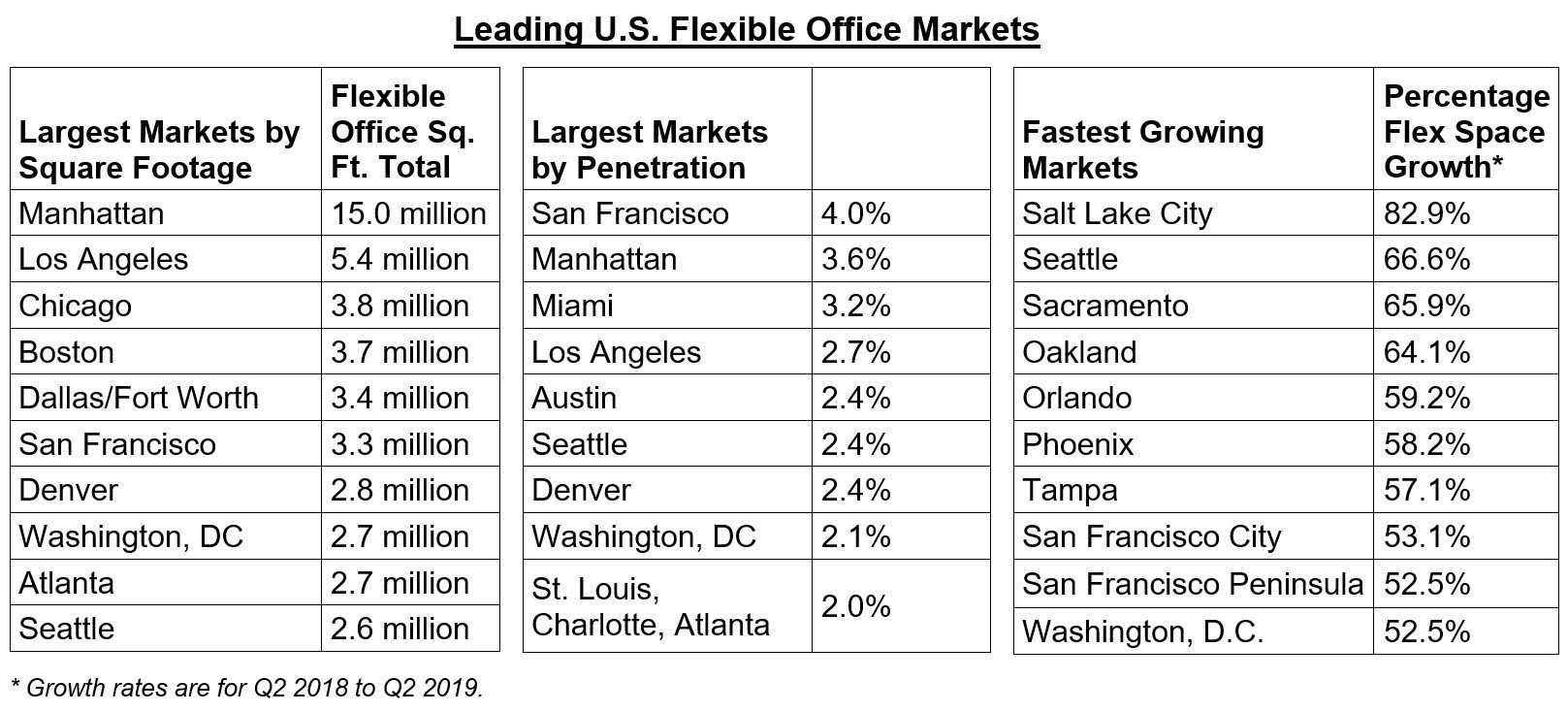by Brianna Crandall — September 18, 2019 — A new report from global real estate advisor CBRE expects the US market for flexible office space will generate significant growth over the next decade, even in the event of a recession, as flex space operators consolidate and forge financial partnerships with building owners.
CBRE outlines several growth scenarios for the flexible office space sector, which currently occupies a cumulative 71 million square feet, or 1.8% of the office space in 40 US markets. CBRE’s baseline forecast calls for flexible office space to expand to approximately 13% of office space by 2030, reaching up to 600 million sq. ft. Even in a low-growth scenario, CBRE sees flexible office space claiming up to 6.5% of the market by 2030.
Fueling that growth is demand from small businesses and enterprise users alike that favor the flexibility of office accommodations on relatively short-term leases, allowing them to expand or contract their space according to the needs of their business. Additionally, the flexible office space category has room to grow in every US market. Even markets where flexible office space is well established — such as San Francisco at 4% of its office market and Manhattan at 3.6% — aren’t as penetrated as major international markets like London and Shanghai, both at 6%, points out the report.
Julie Whelan, CBRE’s Americas head of Occupier Research, stated:
We’re seeing a fundamental change in the expectations that organizations and their employees have for the workplace. This change is spurring an increasing number of companies to engage with flexible office solutions that provide the physical environment and business terms they prefer. This shift is ongoing. There are some very bold predictions in the marketplace — with some calling for flexible space accounting for as much as 30% of office space in the future. There is simply not enough available office space to support this supply without even more drastic changes in tenant behavior.
CBRE believes flexible space can account for as much as 22% of office space by 2030 under the most aggressive flex-space adoption scenario.
CBRE’s analysis found the majority of flexible-space supply in the US concentrated in top markets, many of them tech hubs. Several of those markets also registered the fastest growth rates in the past year.
An economic slowdown would naturally slow the flexible office space sector’s meteoric growth, spurring consolidation among the sector’s flex operators and a shift among the flex formats that operators and landlords use, according to CBRE’s analysis.
In recent years, most flex operations were established in the traditional format of a third-party operator leasing space from a landlord. Three additional formats have emerged:
- In the partnership model, the flex operator and landlord enter a partnership to share the operation’s profits and losses.
- Under the operating agreement model, the third-party operator runs the business for a fee from the landlord, which retains control of the space and revenue.
- The captive format entails the landlord operating all aspects of its flexible office space on its own.
CBRE’s report posits that an economic slowdown might push more operators and investors toward a partnership model, allowing the investor to support the operator through the slowdown and then share in the upside when the economy regains strength. It could also spur some investors to consider operating agreement or captive models, giving them more direct influence on the offering.
Let’s Talk About Flex: The U.S. Flexible Office Market in 2019 is available for free download from the CBRE website. With more than 90,000 employees in 480 offices worldwide, Fortune 500 and S&P 500 company CBRE offers a broad range of integrated services including facilities, transaction and project management; property management; investment management; appraisal and valuation; property leasing; strategic consulting; property sales; mortgage services and development services.





